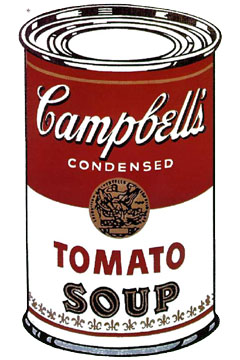
Office: HGH 210; phone: (408) 924-5378
Email: wooda@email.sjsu.edu
Web: http://www.sjsu.edu/faculty/wooda
 |
Dr. Andrew Wood Office: HGH 210; phone: (408) 924-5378 Email: wooda@email.sjsu.edu Web: http://www.sjsu.edu/faculty/wooda |
Reading:
Sturken, M, & Cartwright, L. (2001). Practices of looking: An introduction to visual culture. New York: Oxford University Press.
| Note: These comments are not designed to "summarize" the reading. Rather, they are available to highlight key ideas that will emerge in our classroom discussion. As always, it's best to read the original text to gain full value from the course. |
 In
Chapter Six (pp. 189-236), the authors explore the emergence of the modern
consumer society - a site wherein self is constructed through acts of consumption
rather than through relationships with family bonds and kinship ties. This society
arises in the age of increasing concentration of strangers in urban areas unified
only by mass mediated advertisements. These ads sell products whose planned
obsolescence affirms the need to train consumers to purchase more products from
the inevitable surplus generated in a capitalist system. Thus advertising invokes
the ideology that consumption is essential for happy citizens. The phenomenology
of consumption becomes increasingly based on spectacle and mobility, most illustrated
by the nineteenth century flaneur and the contemporary shopping mall stroll.
Given the seemingly perpetual movement of individuals and shift of scenes in
which individuals find themselves, the visual image must be reformatted to accommodate
continual change and an ever fickle eye. Moreover, the authors note the rise
of Late Modern or Postindustrial Capitalism defined by the global
exchange of objects and, increasingly, nonmaterial items of consumption. Thus,
brands, fashions, and images become less connected to material resources even
as their production, distribution, and consumption continue to possess material
impacts.
In
Chapter Six (pp. 189-236), the authors explore the emergence of the modern
consumer society - a site wherein self is constructed through acts of consumption
rather than through relationships with family bonds and kinship ties. This society
arises in the age of increasing concentration of strangers in urban areas unified
only by mass mediated advertisements. These ads sell products whose planned
obsolescence affirms the need to train consumers to purchase more products from
the inevitable surplus generated in a capitalist system. Thus advertising invokes
the ideology that consumption is essential for happy citizens. The phenomenology
of consumption becomes increasingly based on spectacle and mobility, most illustrated
by the nineteenth century flaneur and the contemporary shopping mall stroll.
Given the seemingly perpetual movement of individuals and shift of scenes in
which individuals find themselves, the visual image must be reformatted to accommodate
continual change and an ever fickle eye. Moreover, the authors note the rise
of Late Modern or Postindustrial Capitalism defined by the global
exchange of objects and, increasingly, nonmaterial items of consumption. Thus,
brands, fashions, and images become less connected to material resources even
as their production, distribution, and consumption continue to possess material
impacts.
 As
commodities become cheaper to produce and increasingly interchangeable, their
creators and distributors must develop ways to increase their exchange value
- typically the monetary "value" of a product - even as the use value
- the relative utility it provides persons and society - remains the same, or
does not exist. Drawing from the Frankfort School, the authors describe the
Marxist critique of the resulting commodity fetishism, in which the actual
means of production and purpose which shapes an object is ignored, replaced
by an artificial set of meanings and values that affirm the ideology of consumption.
In contrast, the authors note Pop Art appropriation of throw-away consumer objects
for artistic purposes. Artists such as Andy Warhol and Roy Lichtenstein celebrated
(even while gently mocking) the very objects that Marxist critics deplore, filling
them with their own meanings. The question remains whether their aesthetic play
did not make them dupes of the "owners of production" in merely another way.
After all, how much free advertising does Campbell's Soup Company get for Warhol's
Two Hundred Campbell's?
As
commodities become cheaper to produce and increasingly interchangeable, their
creators and distributors must develop ways to increase their exchange value
- typically the monetary "value" of a product - even as the use value
- the relative utility it provides persons and society - remains the same, or
does not exist. Drawing from the Frankfort School, the authors describe the
Marxist critique of the resulting commodity fetishism, in which the actual
means of production and purpose which shapes an object is ignored, replaced
by an artificial set of meanings and values that affirm the ideology of consumption.
In contrast, the authors note Pop Art appropriation of throw-away consumer objects
for artistic purposes. Artists such as Andy Warhol and Roy Lichtenstein celebrated
(even while gently mocking) the very objects that Marxist critics deplore, filling
them with their own meanings. The question remains whether their aesthetic play
did not make them dupes of the "owners of production" in merely another way.
After all, how much free advertising does Campbell's Soup Company get for Warhol's
Two Hundred Campbell's?
Briefly, the authors remind us of the role of intepellation in advertisements as text and images seek to "hail" us assume that the ad speaks to us. From that relationship, individuals might imagine themselves into the idealized vision created by the advertisement, visualizing themselves "completed" by consumption of the product. Intriguingly, mass produced objects often become sold as means to distinguish ourselves from others, even as ads seek to distinguish interchangeable consumables from each other. Even so, this idealized vision often demands comparison between ourselves and what we lack. Drawing from the psychoanalytical theories of Jacques Lacan, the authors describe this lacking as a state born from our desire to return to an infantile state of completeness with our mothers. Borrowing from the writings of Michel Foucault, the authors remind us of our willingness to become docile bodies, shaping and contouring ourselves to conform to the mediated images we see. From this perspective, however, our docility affirms institutional strategies of surveillance and control, not psychological needs of affirmation and return. We must recall that advertisements also invite us to imagine ourselves as "other" than the norm, often by employing "marked" signs such as "exotic" locales and ethnicities. The irony, of course, is that consumers seek these "alternative" or "hip" products to appear different while buying into the same ideological assumption: the good life must be purchased.
After noting ways in which individuals may use products or their advertisements of counter-hegemonic purposes through bricolage - and the ways in which corporations turn those acts of bricolage into new products to purchase - the authors explore the transformation of logos into free-floating signifiers whose meanings do not necessarily point to products at all. Consider how many logos you wear, use to beautify your personal spaces, and employ to define your personality. At some point, does the sign system of logos point to a disparate pile of products, or to a product you are advertising: yourself? Concluding this chapter, the authors note various forms of resistance in which advertisements become "jammed" or "hacked" to shock viewers into new and potentially revolutionary perspectives on our media saturated culture, and upon the products we consume.
Activity
Select a magazine advertisement and describe the ways it seeks to co-opt critique to sell a product.